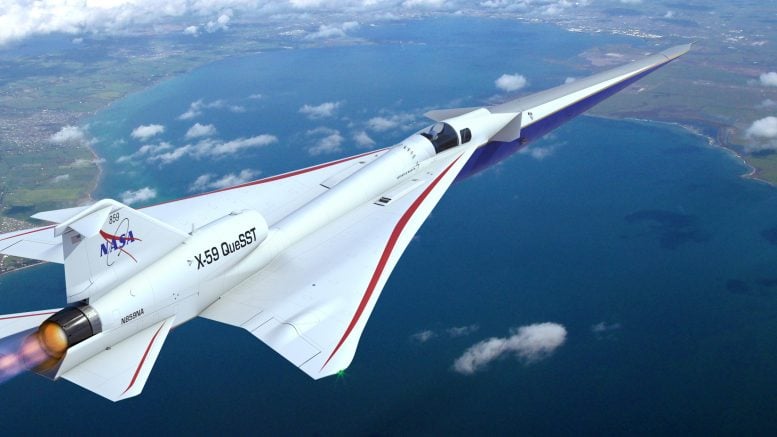NASA recently unveiled its highly anticipated X-59 Quiet SuperSonic Technology (QueSST) aircraft, developed in collaboration with Lockheed Martin’s Skunk Works. This revolutionary plane aims to reduce the disruptive sonic booms caused by supersonic flight to quiet “sonic thumps”, potentially paving the way for mainstream commercial supersonic air travel.
A Gamechanger for Supersonic Travel
For decades, supersonic travel over land has been heavily restricted due to the loud sonic booms it creates. The unveiling of the X-59 marks a pivotal milestone in NASA’s mission to develop quiet supersonic aircraft that drastically soften those booms.
“The X-59 is the culmination of decades of NASA research that sets the stage for the future of quiet supersonic commercial air travel over land,” said NASA Administrator Pam Melroy.
If successful, the X-59 could enable supersonic routes over land for the first time since the Concorde’s retirement in 2003, drastically reducing flight times across continents.
A Unique Aircraft Design
The X-59 features a long, slender fuselage and distinctive cranked arrow wing optimized to fly efficiently at supersonic speeds while generating minimal sonic booms.
The X-59’s 30-foot long nose provides pilots with enhanced visibility despite not having a front windshield. (Source: SciTechDaily)
Notably, the X-59 lacks a forward-facing windshield. Instead, pilots will rely on an advanced augmented reality display system providing critical flight data and a synthesized, enhanced forward view.
From the Skunk Works to Flight
On January 13th, Lockheed Martin officially rolled the completed aircraft out of its top-secret Skunk Works advanced development facility in Palmdale, California.
“Delivering the X-59 to NASA is an incredible milestone for the Skunk Works team and the QueSST program,” said Skunk Works President Jeff Babione.
Over the next few months, the aircraft will undergo critical ground testing before its highly anticipated first flight this summer from NASA’s Armstrong Flight Research Center in Edwards, California.
Demonstrating Quiet Supersonic Flight
Starting in 2024, NASA plans to fly the X-59 over select US towns to gather data on public perception of its sonic “thumps”. The goal is to demonstrate that the aircraft produces booms quiet enough for unrestricted supersonic flight over land.
“If we can fly supersonically and people don’t even notice it, we’ll have succeeded,” said project manager Catherine Bahm.
| Phase | Timeframe | Objectives |
|---|---|---|
| Ground Testing | Early 2024 | Validate aircraft performance prior to first flight |
| Flight Testing | Mid 2024 | Prove quiet supersonic concepts, capabilities over Edwards AFB |
| Community Response | 2025-2027 | Quantify public perception of quiet sonic thumps |
| Data Analysis | 2027-2028 | Provide regulators data to change policies for quiet supersonic flight |
Key project roadmap phases and objectives through 2028 (summarized from multiple sources).
The data gathered will ultimately support new sound-based rules for future supersonic flight, replacing today’s impractical speed restrictions.
Looking to the Future
The X-59 sets the stage for a new generation of environmentally friendly supersonic transports. Lockheed Martin already has concepts in development for quiet 70 to 120-passenger airliners with the X-59’s key attributes.
If testing proves successful, such aircraft could enter service by 2030, offering business and premium leisure travelers routine supersonic flight options. That possibility hints at a future where enhanced mobility helps economies, businesses, and families thrive through faster connections.
With the X-59 now rolled out, NASA is primed to enable that future by unleashing innovation in sustainable supersonic flight.
To err is human, but AI does it too. Whilst factual data is used in the production of these articles, the content is written entirely by AI. Double check any facts you intend to rely on with another source.



